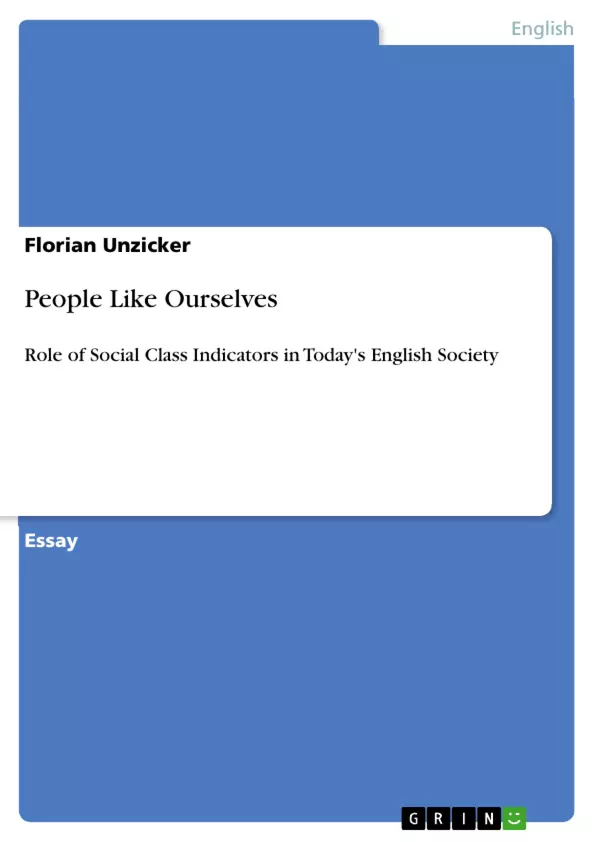In 1940, famous George Orwell accepted as a fact that England was ''the most class-ridden society under the sun." The traditional class distinctions have been blurred since the egalitarian revolution of the 60s, what has gone is at least ''the will to erect, maintain and police such distinctions.'' However, today England still is a highly class-conscious culture and people seem to have very sensitive antennas to localise their fellow Englishmen's exact position on the social map. This essay is supposed to examine how these ''on-board class-radar systems'' work, that means by which criteria social class is distinguished in today's English society.
Inhaltsverzeichnis (Table of Contents)
- Introduction
- Class Indicators: Occupation, Income, and Wealth
- The Middle Class: A Heterogeneous Group
- The Upper Class: Wealth and its Shifting Significance
- Beyond Economics: Language and Manners
- Speech Patterns: Pronunciation and Terminology
- The Significance of Word Choice
- Dress and Appearance as Class Markers
- Clothing Styles: Men
- Clothing Styles: Women
- Housing and Interior Decoration
Zielsetzung und Themenschwerpunkte (Objectives and Key Themes)
This essay aims to explore how social class is perceived and distinguished in contemporary English society. It moves beyond traditional economic indicators to examine the subtle and complex ways in which class is communicated and understood.
- The evolution of class indicators in England since the 1960s.
- The role of occupation, income, and wealth in shaping class perceptions.
- The significance of language (pronunciation and word choice) as a class marker.
- The use of dress and appearance as subtle indicators of social class.
- The importance of housing and interior decoration in signifying social status.
Zusammenfassung der Kapitel (Chapter Summaries)
The Introduction sets the stage by discussing the enduring nature of class consciousness in England, despite the blurring of traditional distinctions.
The section on Class Indicators: Occupation, Income, and Wealth examines how occupation, particularly the possession of a university degree, has historically indicated class membership. It further explores the complexities of defining the middle class and the changing role of wealth in determining social status, highlighting the rise of the nouveau riche and the complexities of class identification that this entails.
The section on Beyond Economics: Language and Manners delves into the use of language as a key class indicator. It discusses how pronunciation (Received Pronunciation vs. working-class accents) and vocabulary choices (U-words vs. Non-U-words) reveal social background, exploring concepts such as shibboleths and the social significance of seemingly minor linguistic variations.
The section on Dress and Appearance as Class Markers examines how clothing choices and styles serve as subtle signals of social class, particularly in the context of generational differences. The essay analyzes differences in taste, the display of brand labels, and the nuances of attire among men and women across different classes.
The section on Housing and Interior Decoration briefly touches upon how housing and interior design choices reveal class distinctions. It highlights the contrast between the inherited wealth and eclecticism of the upper class and the aspirational homeownership often associated with the middle class.
Schlüsselwörter (Keywords)
Social class, England, class indicators, occupation, income, wealth, language, speech patterns, pronunciation, vocabulary, dress, appearance, housing, interior decoration, Received Pronunciation, U-words, Non-U-words, social stratification, class consciousness.
- Arbeit zitieren
- Florian Unzicker (Autor:in), 2008, People Like Ourselves, München, GRIN Verlag, https://www.grin.com/document/121581



